Analyzing Moissanite Diamond Pricing Dynamics
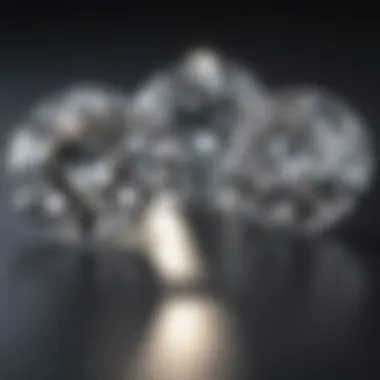
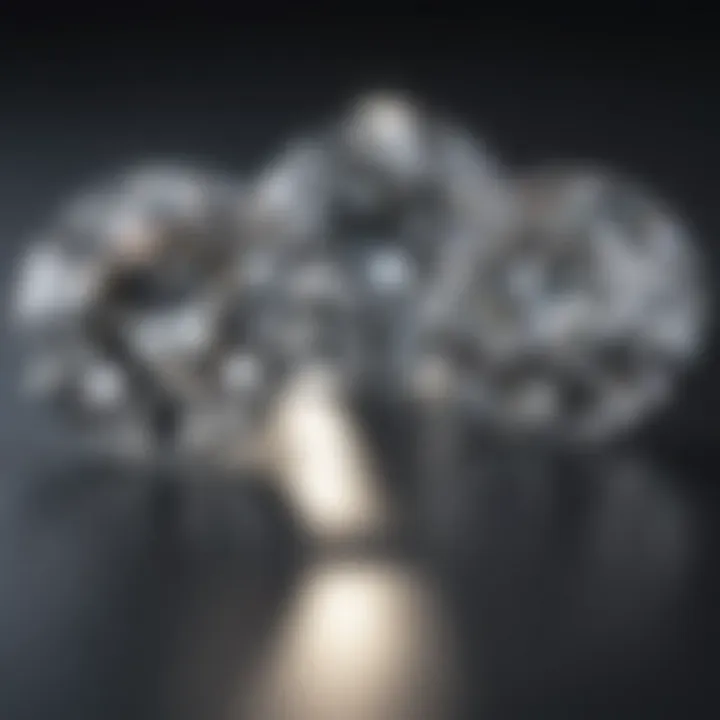
Intro
In the world of gemstones, moissanite has soared in popularity, shining brightly as a cost-effective and dazzling alternative to traditional diamonds. Understanding how the cost of these gemstones comes into play can be quite the eye-opener for those looking to make informed decisions in their purchases. It’s not just about what sparkles on the outside; various factors contribute to their price point, and knowing these can help buyers navigate the market more effectively.
Gemstone Overview
Definition of Gemstones
Gemstones, often referred to as precious or semi-precious stones, are naturally occurring minerals that are cut and polished for use in jewelry and ornamentation. What distinguishes a gemstone in the market is often its rarity, beauty, and ability to be fashioned into various forms. Moissanite, a silicon carbide mineral, fits the bill here as it shines brightly like diamonds, but these stones are made synthetically, which plays a significant role in their pricing.
Classification of Gemstones
Gemstones can be broadly classified into two categories: precious stones and semi-precious stones. Traditional precious stones include diamonds, rubies, sapphires, and emeralds—rocks that have garnered lifelong allure and high market values.
On the other hand, semi-precious stones like amethyst or garnet, lack the same level of prestige but can still be beautiful and valuable. Moissanite is typically categorized as a lab-created or synthetic gemstone.
"Unlike natural diamonds that are formed over billions of years deep within the Earth, moissanite crystals are much easier and faster to produce, which significantly influences their cost structure."
Historical Significance
Origins of Gemstone Use
The history of gemstones stretches back thousands of years. Each stone has a tale to tell, often linked to cultural beliefs and trade. Moissanite itself was discovered in 1893 by the French chemist Henri Moissan, but it wasn’t until the late 20th century that it began to be used in jewelry. This relatively recent introduction still places moissanite in a context of modern gemstone appeal, surrounded by consumer interest.
Cultural Insights: Gemstones in Ancient Civilizations
Throughout history, gemstones have held symbolic meanings across various cultures. Ancient Egyptians, for instance, believed that certain stones offered protection and promoted healing and vitality. This ancient legacy of gemstones rings true even today as moissanite finds its way into engagement rings, symbolizing commitment without breaking the bank. People today appreciate not just its sparkle, but the rich history that gemstones, including moissanite, carry.
Understanding these facets of moissanite diamonds not only highlights what makes them special but opens up a conversation about their cost dynamics in the market.
Prologue
The allure of moissanite lies not only in its brilliance but also in its affordability. These stones have gained traction due to their striking visual qualities, often compared to their natural counterparts while being substantially less expensive. This article aims to dissect various elements that contribute to their price, thus assisting potential buyers in navigating the complex landscape of gemstone options.
By grasping the nuances of cost components, consumers can make informed decisions. Key topics, such as market trends and factors affecting value, will be explored to highlight why understanding these aspects can significantly affect purchasing choices. The purpose extends beyond mere awareness; by grasping the economics behind moissanite diamonds, buyers can ensure their investments resonate with their budgetary constraints and personal aesthetics.
Overview of Moissanite
Moissanite, discovered in 1893 by Henri Moissan, is a gemstone that mimics the optical properties of diamonds. Primarily composed of silicon carbide, it exhibits a refractive index higher than that of diamonds, resulting in a distinct fire and brilliance. This unique composition gives moissanite a striking resemblance to natural diamonds while providing additional benefits, including lower cost and durability.
As a synthetic stone, moissanite is created in laboratories, ensuring consistent quality and a broader selection of sizes and shapes. This manufacturability has led to a diverse array of moissanite options on the market, making them accessible across different consumer demographics.
Yet, despite its synthetic nature, moissanite is often compared to natural diamonds, especially in terms of appearance and longevity. Given its unique characteristics, moissanite represents a viable choice for those prioritizing beauty and budget.
Purpose of the Article
Additionally, the article aims to compare moissanite pricing with that of traditional diamonds. This comparative analysis is vital as it not only highlights cost differences but also informs readers about the longevity and durability of both types of gemstones. The idea is to equip potential buyers with knowledge that promotes informed decisions, ensuring satisfaction with their chosen gemstones.
Through careful examination of market trends and purchasing behavior, the narrative successfully demonstrates how external influences shape consumer choices. Ultimately, this article serves as a valuable resource for gemstone enthusiasts, collectors, and those looking at moissanite as a cost-effective alternative to natural diamonds.
The Basics of Moissanite Diamonds
Understanding the basic elements of moissanite diamonds is crucial for anyone delving into the world of gemstones. This section lays a solid foundation, highlighting essential characteristics, composition, and how moissanite stacks up against its traditional counterpart: natural diamonds. You can think of this as understanding the engine before appreciating the sleek body of a high-performance car; the more you know about the inner workings, the more you'll appreciate the overall package.
Composition and Characteristics
Moissanite, originally discovered in a meteor crater by Henri Moissan in 1893, is primarily made up of silicon carbide. This unique composition gives it exceptional qualities. To put shoes on the ground, moissanite ranks 9.25 on the Mohs scale of hardness, making it one of the toughest gemstones available, only slightly second to diamond.
When it comes to brilliance, moissanite shines brighter than a traditional diamond, refracting light in a way that can be almost overwhelming. Its fire—the term used to describe how light disperses into different colors—is impressive and can be a talking point for enthusiasts. Also, the clarity of moissanite, often marketed as being flawless, can be a real draw for buyers. In summary, if you are in the market, knowing these characteristics can help ensure you get a high-quality product.
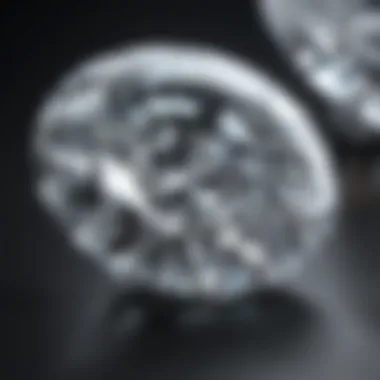
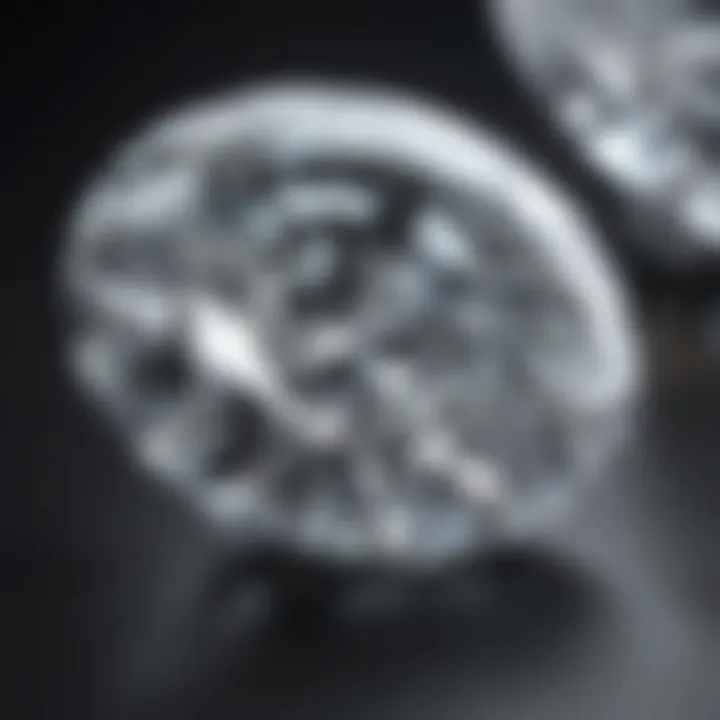
Comparison with Natural Diamonds
Now, comparing moissanite with natural diamonds can feel like apples and oranges, but there are quite a few critical angles to consider. First off, the price difference is striking. You might find that moissanite is generally offered at about a fraction of the cost of diamonds. While it’s not necessarily a knock against diamonds, understanding why this difference arises is vital.
Moissanite is lab-created, meaning that the production costs are lower than for mined diamonds, which require extensive resources and time. If you ask jewelry designers, many will tell you that moissanite stones can achieve the same aesthetic appeal for much less money.
However, some consumers may harbor reservations about the authenticity of lab-created gems. When the average Joe looks at a piece of jewelry, they might not have an eye trained to distinguish between the two stones, and a well-crafted moissanite piece can look just as enticing as its more expensive siblings. Significant differences exist, though, particularly in terms of emotional and social status attached to diamonds.
Thus, a discerning buyer must weigh the personal value, emotional connections, and financial implications before deciding between the two. Understanding these nuances makes you better equipped to make informed purchases.
"The decision to choose moissanite or diamond boils down to personal preference and understanding the inherent values of each gem."
Factors Influencing the Price of Moissanite
Understanding the factors influencing the price of moissanite diamonds is crucial for anyone looking to invest in these sparkling alternatives to natural diamonds. Various elements come into play when determining price points, including quality, size, origin, and market demand. By delving into these specific factors, we're equipping potential buyers and gemstone enthusiasts with the necessary insight to make informed decisions about their purchases.
Quality and Clarity Grades
When it comes to evaluating the price of moissanite, quality and clarity grades are paramount. Just like natural diamonds, moissanite stones are assigned clarity grades based on their appearance and internal characteristics. The Gemological Institute of America (GIA) and other certifying bodies use a scale ranging from Flawless (FL) to Included (I). Stones that fall into the VS1 (Very Slightly Included) or VVS2 (Very Very Slightly Included) categories typically fetch higher prices because they feature fewer visible inclusions and offer more brilliance.
Moreover, the way light interacts with these gems – their fire and scintillation – can also significantly affect the perceived quality. A well-cut moissanite stone will display a dazzling play of light, attracting a higher price. Factors that buyers should keep in mind include:
- Inclusion types: Internal flaws such as feathering or air bubbles can lower the grade.
- Cut quality: A good cut enhances light performance and overall appearance.
- Color grade: While most moissanite diamonds maintain a near-colorless appearance, some stones may have yellow or green tints, influencing their value.
Carat Weight Considerations
Carat weight is another significant factor that impacts the pricing of moissanite diamonds. Simply put, the larger the stone, the higher the cost. However, it's essential to note that moissanite is denser compared to diamonds; hence, a one-carat moissanite may appear slightly smaller than a corresponding diamond.
Typically, stones in the range of one to two carats are in higher demand, seeing a proportional increase in price for each additional carat. Carat weight considerations also encompass:
- Rarity: Finding larger moissanite stones is rare, mirroring traditional gems' trends.
- Shape: Certain cuts, such as round or princess, are more sought after, impacting price dynamics.
- Market trends: Fluctuating consumer preferences can lead to price changes based on demand for larger sizes.
Lab vs. Natural Stones
In the realm of moissanite pricing, the differentiation between lab-created and natural stones mustn't be overlooked. Most moissanite on the market today is lab-created, which often results in lower prices when compared to natural diamonds. While both types may offer similar aesthetic qualities, lab-made moissanite often comes with advantages in pricing stability and ethical considerations.
Here are some key comparisons to consider:
- Cost Efficiency: Lab-created stones are generally cheaper due to controlled production processes.
- Ethics and Environmental Impact: Many consumers view lab-grown gems as a sustainable choice, steering away from the potential ethical concerns associated with traditional mining practices.
- Innovation: Advances in technology are continuously improving the quality of lab-created stones, sometimes surpassing natural options.
Current Market Trends
Understanding the dynamics of current market trends surrounding moissanite diamonds can illuminate a lot about their growing popularity and pricing strategies. In the shifting landscape of gemstone sales, trends can heavily influence consumer choices and subsequently their willingness to invest in a piece of jewelry. For potential buyers, awareness of these trends aids in making informed spending decisions.
Popular Designs and Styles
Moissanite has found its way into various designs and styles, catering to diverse consumer preferences. From classic solitaires to intricate halo settings, the designs keep evolving, attracting a broad audience. Popularity can shift based on seasonal trends or even influencers' preferences.
- Vintage styles are gaining traction, where moissanite's sparkle enhances delicate filigree settings.
- Contemporary and minimalist designs cater to a younger audience that seeks simplicity yet elegance.
- Unique shapes like hearts and pears have started attracting attention, showcasing moissanite's versatility.
The ability to customize moissanite pieces adds to their appeal. Jewelers often provide tailored designs, ensuring buyers find something that truly resonates with their personal style.
Consumer Buying Behavior
Understanding consumer buying behavior in the moissanite market reveals trends driven by various factors. Many consumers now prioritize ethical choices and sustainability, significantly shaping their decisions. Moissanite's lab-grown aspect resonates with this demographic, as they seek alternatives to mined stones. Additionally, potential buyers weigh financial benefits.
- Price sensitivity plays a critical role; moissanite is perceived as a cost-effective option compared to traditional diamonds.
- Many view moissanite not just as an economically sound decision but also as an intentional choice that reflects their values.
- Word-of-mouth recommendations and online reviews often sway buyers, making social proof essential in today’s market.
Impact of Celebrity Endorsements
The impact of celebrity endorsements cannot be understated in the realm of moissanite diamonds. As public figures showcase their love for these gems, they spark interest among fans and followers. Celebrities adopting moissanite settings can shift consumer perceptions and foster a sense of trendiness around these stones.
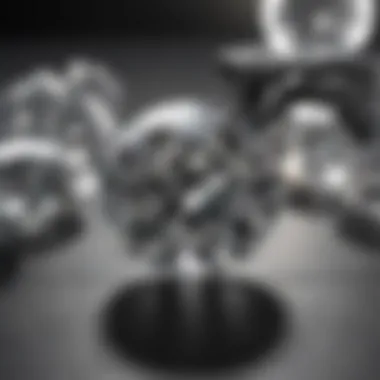
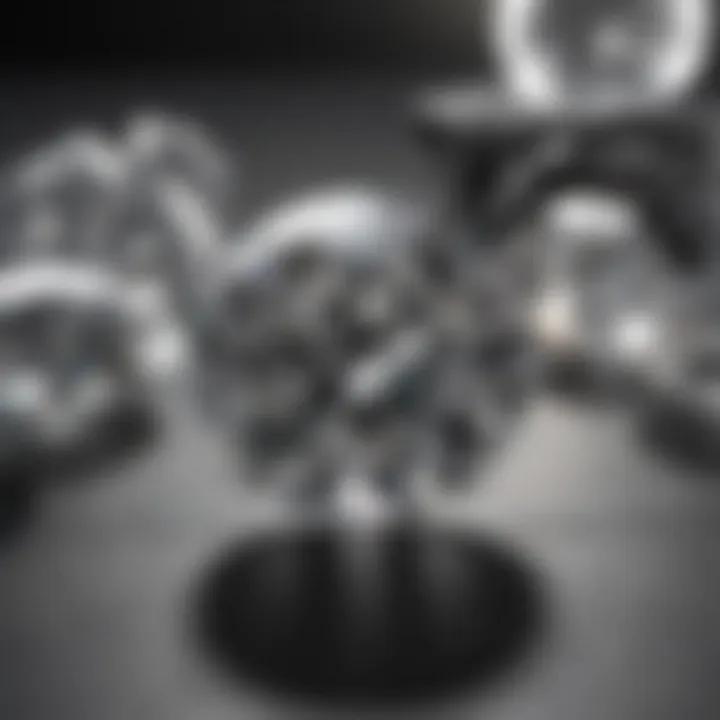
When stars, especially in engaged or committed relationships, are seen flaunting moissanite rings, it can lead to significant market interest. For instance:
- High-profile engagements that feature moissanite can catapult the stones into the limelight, creating an immediate spike in consumer inquiries.
- Social media platforms have enabled a rapid spread of images showcasing beautiful moissanite jewelry worn by famous personalities, drawing the eyes of potential consumers.
- Furthermore, collaborations between jewelers and celebrities can lead to unique collections that further entice buyers, blending style with investment.
Comparative Analysis with Traditional Diamonds
As we unravel this comparison, the distinction between price and value becomes evident. Both stones have unique benefits that make them appealing, but exploring the cost differences essentially shows why moissanite might be the smart alternative for many consumers.
Price Differences
When laying out the price comparison, moissanite clearly stands apart from traditional diamonds. On average, a moissanite diamond can cost anywhere between 10 to 15 percent of what a comparable natural diamond would fetch. This stark contrast can be illustrated with the average price range for each:
- Moissanite diamonds: About $400 to $700 per carat.
- Natural diamonds: Typically, $4,000 to $12,000 per carat, depending on various factors including carat weight and quality.
This price disparity leads many buyers to consider moissanite seriously, especially those who may be more price-sensitive or looking to purchase larger stones without breaking the bank. In today’s market, savvy consumers are increasingly recognizing that spending less does not automatically equate to compromising on beauty or quality. Instead, they find they can often attain a larger and more visually impressive stone with moissanite.
"For many, the allure of moissanite lies in its ability to mimic a diamond's brilliance at a fraction of the cost."
Durability and Longevity
Another factor often overlooked is the durability of moissanite compared with traditional diamonds. Moissanite ranks at a 9.25 on the Mohs scale of hardness, trailing only diamonds, which score a perfect 10. This makes moissanite remarkably resistant to scratches and showing wear over time. Thus, the longevity of a moissanite stone often parallels that of its diamond counterpart.
In practical terms, this means that a moissanite ring can withstand daily wear just as effectively as a diamond one, making it an excellent option for engagement rings or other pieces meant for frequent use. Buyers often appreciate knowing that they’re choosing a stone capable of enduring the rigors of everyday life while still possessing exceptional beauty.
Overall, the comparative analysis of moissanite and traditional diamonds boils down to personal preference, budget constraints, and lifestyle. With both stones offering unique advantages, the debate often hinges on individual values related to aesthetics and financial considerations.
The Impact of Certification on Price
The discussion surrounding the price of moissanite diamonds cannot be disentangled from the role of certification. Certification serves as a beacon of clarity and reliability in the often murky waters of gemstone valuation. It provides both buyers and sellers with an assurance that the stone meets certain quality standards. But why is this significant? For those engaged in the world of jewelry, especially gemstone enthusiasts and collectors, understanding certification is an integral part of making informed purchasing decisions.
When a moissanite stone is certified, it typically undergoes thorough evaluation by a recognized gemological laboratory. These institutions assess various characteristics such as
- Clarity
- Color
- Cut
- Carat Weight
Having this information at hand can elevate the stone’s perceived value. Essentially, a credible certification can add a layer of trustworthiness to the seller’s claims. The difference between a certified and an unverified stone can be as stark as night and day; the former often commands a higher price point due to the assurance that comes with quality verification.
"A well-certified stone is like a well-tuned instrument; it brings harmony to the buyer's experience and can easily stand against its natural counterparts."
Importance of Certification for Value Assessment
The essence of certification in the context of moissanite diamonds extends beyond mere price tag inflation; it influences the overall perception of worth within the market. Think of it as the difference between a sketch from a budding artist and a painting by a renowned master. A certification provides a badge of honor, so to speak, making the stone more attractive.
Buyers looking to invest often feel reassured knowing that the stones they're considering have been systematically evaluated. Furthermore, if you decide down the line to resell your moissanite, having a certification in hand can help you maximize your return on investment.
Several key factors regarding certification come into play when assessing value:
- Independent Verification
A certification from a respected lab ensures that an unbiased third party has validated the stone. - Market Confidence
Such validation cultivates confidence among potential buyers, reducing uncertainty. - Ease of Comparison
When two stones are certified, it simplifies the comparison and decision-making process. - Long-term Value
Certified stones are likelier to maintain or even appreciate in value over time.
In summary, the bearing of certification on the price of moissanite diamonds is profound. It extends beyond the transactional aspect and enters the realm of trust, integrity, and long-term value retention. Investors, collectors, and enthusiasts alike should give considered thought to certification, ensuring that any purchase they make is informed and genuine.
Regional Pricing Variations
Understanding how the price of moissanite diamonds fluctuates across different regions is crucial for anyone looking to buy or invest in these stunning gemstones. The variances in cost can be attributed to numerous factors including local market dynamics, labor costs, supply chain logistics, and consumer demand.
For gemstone enthusiasts, knowledge of these regional differences can help identify the best places to purchase moissanite at competitive prices, while collectors interested in expanding their collections can refine their strategies based on localized pricing trends.
Global Market Influences
The global market plays a pivotal role in setting the price of moissanite diamonds. Factors such as international trade agreements, tariffs, and fluctuations in currency values can sharply impact the final cost. For instance, regions that import moissanite may incur higher expenses due to shipping and import duties.
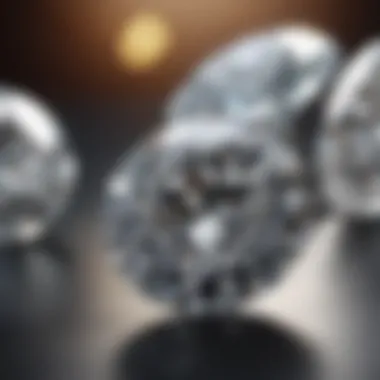
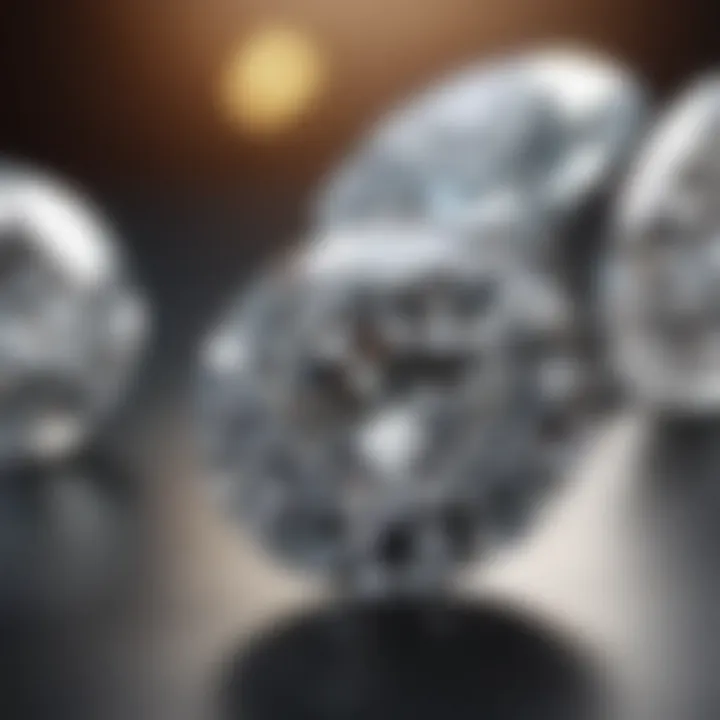
- Exchange Rate Variations: The exchange rate fluctuates daily. A strong currency in a buying nation can lower prices, while a weaker currency might spike costs.
- Trade Tariffs: Countries impose import taxes. These tariffs can make moissanite more expensive in some regions than others. Buyers might notice a stark difference if they look at moissanite prices in the United States vs. countries that import them with hefty tariffs.
- Local Production: Areas with local production facilities may offer moissanite at reduced costs, assuming they have efficient supply chains that streamline distribution.
It’s also beneficial to keep an eye on market reports from industry insiders, as trends like synthetic diamond cultivation may shift overall market prices.
Cultural Perceptions of Moissanite
Cultural attitudes towards moissanite also influence its pricing across various regions. The gemstone often carries different connotations and levels of desirability depending on local customs and societal trends.
For example:
- In some cultures, moissanite is celebrated for its affordability and brilliance, leading to higher demand and resulting in a priced increase. Such a scenario is commonly observed in regions with a high appreciation for sustainable and ethical luxury goods.
- Conversely, in markets that highly value natural diamonds, moissanite may face brand perception challenges, with buyers less willing to embrace its sparkly alternative, potentially keeping prices lower in those areas.
Understanding this perspective allows buyers and sellers alike to adapt their strategies. By analyzing how cultural narratives shape buying habits, one can better gauge when to invest, sell, or promote moissanite diamonds.
"The price of a gem is not just about its material worth but also the dreams, stories, and cultural context wrapped around it."
These insights show that regional pricing variations are not merely economic phenomena; they encapsulate broader social views and preferences.
By tapping into these regional influences, potential buyers can position themselves favorably in the market while also appreciating the intricate web of factors that lead to the pricing of moissanite diamonds. Whether it’s scouting the best deals or understanding how to negotiate prices, being aware of these dynamics is essential.
Future Prospects for Moissanite Pricing
As we look to the horizon, it's clear that understanding the future prospects for moissanite pricing is essential for anyone interested in the gemstone market. The jewel's growing popularity among various demographics means that price fluctuations are a tangible consideration for buyers and sellers alike.
In this section, we will explore some pivotal elements shaping the future pricing landscape of moissanite diamonds, including technological innovations and shifts in consumer preferences. Identifying these trends can empower enthusiasts and collectors to make informed decisions in their investment choices.
Technological Innovations
Technological advancements are the backbone of any modern industry, and that rings true for gemstone production. In the realm of moissanite, cutting-edge technology enhances both the quality and affordability of the stones.
For instance, the methods for synthesizing moissanite have become more sophisticated, allowing manufacturers to produce larger stones at reduced costs. This enhancement can lead to lower prices for consumers, as the overhead associated with production decreases. Additionally, advancements in clarity enhancement techniques have been made, which can significantly increase the visual appeal of these gemstones without a substantial price increase.
"Innovations in gemstone synthesis not only boost quality but also help in keeping prices in check."
However, it's not just about cost efficiency. New processes, like improved gem-growing techniques, mean that gemstones can be created with more precision than ever before. This elevation in quality can lead to increased demand, as consumers become more discerning in their choices, possibly pushing prices upward if demand exceeds supply.
Shift in Consumer Preferences
Consumer sentiment has the power to steer market dynamics, and moissanite diamonds are no exception. In recent years, there's been a noticeable shift toward more environmentally sustainable and ethically sourced options. As more individuals become aware of the environmental and ethical implications of mining natural diamonds, many are turning to moissanite and similar alternatives.
This trend is significant because as the demand for moissanite continues to escalate, it carries the potential to influence pricing structures. If buyers increasingly opt for moissanite due to its eco-friendliness and affordability, we could see a consolidation of market position that results in stabilized or even increasing prices.
Furthermore, the millennial and Gen Z generations are particularly drawn to moissanite, valuing unique styles and personal expression over traditional symbols. With social media powering trends, the popularity of certain designs can fluctuate overnight, impacting the overall demand and, consequently, the prices of moissanite gems. In this case, staying informed about consumer preferences and market trends can be a valuable strategy for both potential buyers and sellers.
Ultimately, the future of moissanite pricing remains intertwined with these emerging technologies and evolving consumer preferences. By keeping an eye on these factors, those in the gemstone community can navigate the market more successfully, ensuring their investments remain sound.
Closure
As we draw this discussion to a close, it's clear that understanding the nuances of moissanite diamond pricing is more than just a superficial endeavor. It’s a gateway to making informed decisions for anyone from gemstone enthusiasts, collectors, to those simply looking to make a prudent choice in their jewelry investments. The intricacies of price framing, market dynamics, and personal preferences play vital roles in shaping the overall cost of moissanite.
Summary of Findings
Throughout this exploration, we’ve touched on several critical points:
- Factors Affecting Cost: We delved into specific characteristics like quality, clarity, and carat weight that distinctly influence the overall price of moissanite diamonds. These elements are essential for prospective buyers to understand, as they impact not just aesthetics but valuation.
- Market Trends: The journey through consumer behavior and the pivotal role of celebrity endorsements has revealed how public perception can sway pricing. As moissanite grows in popularity, understanding market trends becomes invaluable for buyers aiming to act strategically.
- Comparative Analysis: By contrasting moissanite with traditional diamonds, we can see clear differences in cost versus beauty, durability, and emotional value. This comparison equips potential buyers with a formidable arsenal of information for making choices that align with their ideals and budgets.
Overall, knowledge is power, especially when it comes to navigating the gemstone market. Being equipped with the right information not only aids in avoiding pitfalls but also enhances one’s appreciation of these sparkling alternatives.
Final Thoughts on Value and Investment
Investing in moissanite diamonds can prove economically savvy, particularly as more consumers shift their focus toward ethical and sustainable options in jewelry. Unlike traditional diamonds, which can carry significant ethical concerns and inflated markups, moissanite offers a stunning alternative that won't break the bank.
This transition isn't just about money; it reflects a changing cultural narrative. People are increasingly valuing authentic beauty and responsible sourcing. With the advancements in technology and production, moissanite is not just a substitute but a worthy contender in its own right.
From a financial stance, whether for adornment or resell, the importance of making informed choices can’t be overstated. By evaluating all aspects of moissanite pricing, from certifications to market trends, buyers can position themselves favorably in this thriving arena.
As we conclude, one thing remains certain: understanding the worth of moissanite isn’t merely an exercise in numbers, but a celebration of innovative gems fitting perfectly into modern lifestyles.



